Discover why you must use long tail keywords in your content. Learn the 4 awesome ways to find long tail keywords in any niche easily.
It’s 2020 and beyond – Long tail keywords are still as important as ever.
However, many people may have forgotten about how valuable this pot of gold can be.
As you’ll see in this article, I’ll be explaining to you why long tail keyword is still as important in this era and what are some of the ways you can find them.
Before that, let’s get down to basics.
What are long tail keywords?
To put it simply, long tail keywords are search phrases with more than three words.
For example:
- “running shoe for men reviews”
- “running shoes brand list”
- “best running shoes in 2019”
This makes them more specific than searches with fewer words like “shoes” and “running shoes”.
Yes, long tail keywords tend to get lesser search traffic than the popular keywords, but the search intent becomes highly targeted.
Why you should use long tail keywords in your content
Using long tail keywords for your content optimization is most definitely worth the time and effort. Whether you are trying to increase your sales or simply drive more traffic to your website, it gives benefits to not just you but also the search engine and your users.
Now, let’s take a look at some of the reasons why you should use long tail keywords in your content.
1. Less Traffic But Lesser Competition
When you are looking for keywords to be used in your content, you want to look for keywords that are not highly competitive but still has a good number of monthly searches. Long tail keyword is your answer.
Here’s an example.
Try Googling “plumbing service”, and you will get about 742,000,000 results in less than a second!

To get into the Top 10 with the same keywords, you may need to spend a lot of resources and still not appear on the Top 3 results. It will be really difficult because you will compete with lots of other high domain authority websites.
What if you add an extra keyword, “repair”, It has become a long tail keyword now hasn’t it? This time around, try “plumbing repair services” and you’ll see that the result has been reduced to 201,000,000. In other words, 70% of competitors are gone.

Let’s filter the competition further. By using a more specific search term that is related to your niche such as “plumbing repair services in Boston”, you will see about 19,600,000 web pages. That comes up to about 37 times lesser in search results when compared to the broad keyword “plumbing service”.

Just 2% of people are really targeting this keyword. This could mean lesser traffic potential, but far lesser competition than the first choice.
So, how much traffic is exactly hidden in long tail?
According to Hitwise’s study published by Bill Tancer and then re-published with some additional insights on the MOZ’s blog, long tail keywords comprise up to 70% of all search traffic!
Just look at the graph below, the number of keywords per search is graphed on the x-axis and the number of searches is graphed on the y-axis.
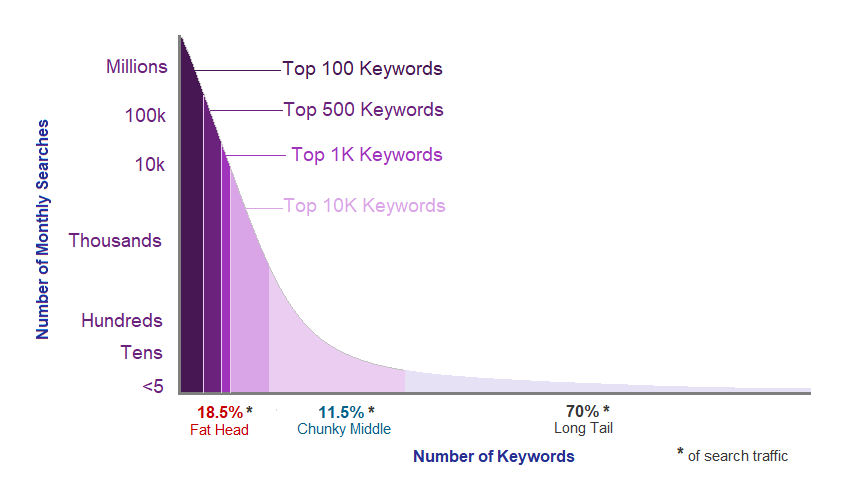
For the Boston-based plumbing service from the example above, such long tail keyword variations may include:
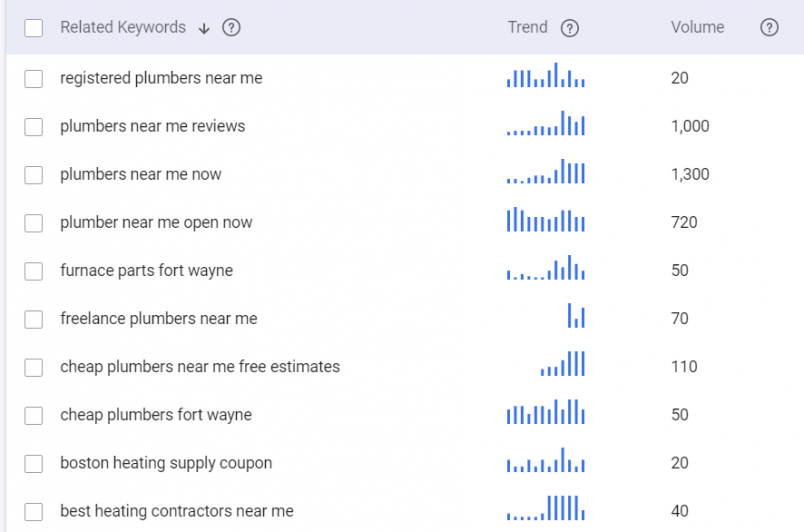
These are all the real keywords I have found with their average monthly search numbers using BiQ’s Keyword Intelligence. You will definitely find more long tail keywords there if you were to conduct more in-depth research.
When it comes to writing content, the aim is to use highly relevant keywords rather than just focusing on the search volume. When combined with the right intention, you may reap the fruits of your labor in no time.
2. Gives You A Highly Targeted Traffic
What’s better than getting the right traffic to your website?
As you have already known, long tail keywords may not attract as much traffic as to how short tail keywords do, but what’s better is it attracts the audience that you are looking for.
The thing about using long tail keywords in your content is that you can instantly filter out the right kind of audience you are targeting.
Let’s see them in action using an example of queries made by a potential prospect, Joseph.
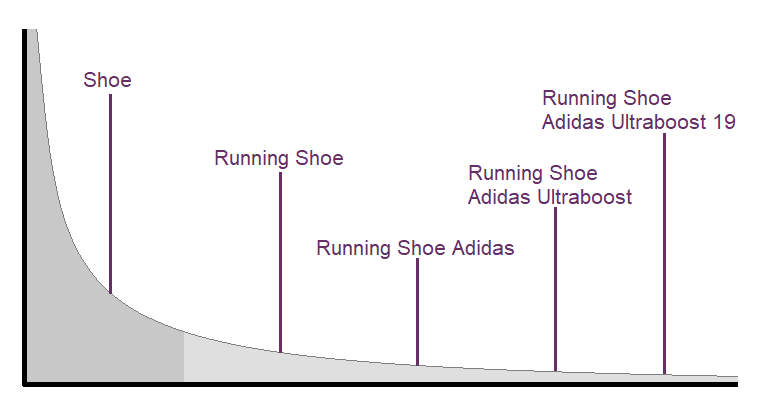
When Joseph does a search on “shoes” and “running shoe”, one may not be able to know exactly what he is really searching for because it is not descriptive enough. In fact, one can never tell the true intention of a person who is searching for a query like “shoes”.
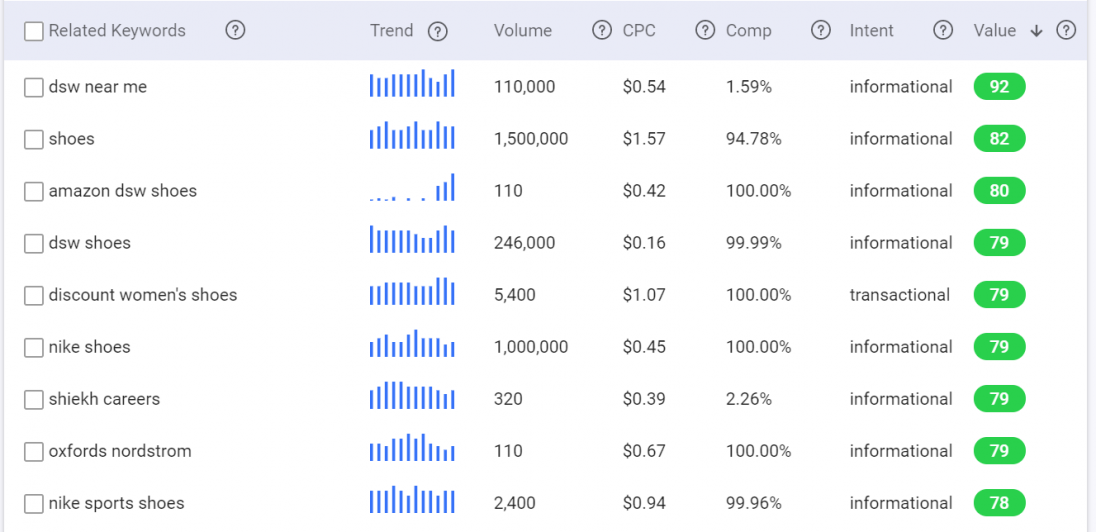
However, this is a different story when he uses a more descriptive, long tail keyword such as “Adidas running shoes Ultraboost 19”. We are now able to make a few closer guesses from his intent that he is interested and is looking for more information about the Ultraboost running shoes.
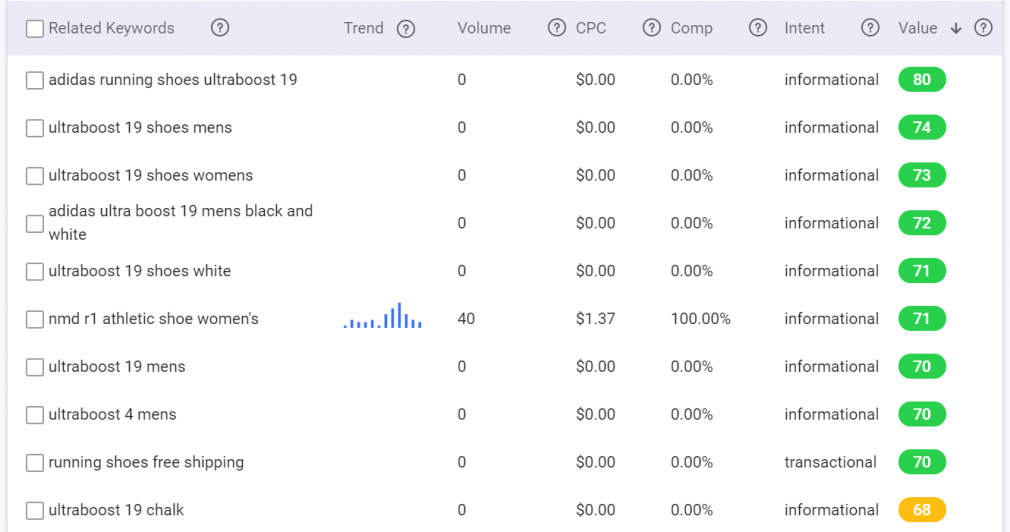
However, this is a different story when he uses a more descriptive, long tail keyword such as “Adidas running shoes Ultraboost 19”. We are now able to make a few closer guesses from his intent that he is interested and is looking for more information about the Ultraboost running shoes.
* Here’s a tip: When writing your content, always put yourself in the searcher’s shoes. Make sure you know what your audience wants from you and give them what they want.
By targeting these limited searched keywords, you are more likely to attract an audience that is more relevant to your content.
3. Long Tail Keywords Have Higher conversion rates
When creating content, what action do you want your audience to take?
According to a study, long tail keywords convert 2.5x higher than the main keywords!
It is not surprising because long tail keywords usually come with higher levels of “searchers intent”. Giving what the user wants in the first place helps to accelerate the conversion rate.
This is because long tail keywords are more specific in nature. Which means searchers are more likely to know what they are looking for when they use long tail keywords in doing their searches.
Coming back to our running shoe example, you can’t possibly predict what Joseph is looking for when he merely types “running shoe” in the search bar.
By adding more variations to the long tail keywords, you can create and deliver the exact content users are seeking at that moment:
- Buy running shoe Adidas Ultraboost 19
- Compare running shoe Adidas Ultraboost 19
- Running shoe Adidas Ultraboost 19 review
- Running shoe Adidas Ultraboost 19 features
- Running shoe Adidas Ultraboost 19 price
To put it briefly, visitors coming from a much more specific term will be far more likely to convert than those coming from generic keywords.
4. Give more context to your main keywords
If you’re in this SEO journey for a long time, you’ll know that Google often updates its algorithm. With the 2017 Hummingbird update, it has been proven that Google wants everyone to focus on contextual searches. This update adjusted search algorithms to match exact phrasing more often to deepen their understanding of a context.
It’s pretty obvious that Google is getting smarter day by day. It starts to understand the content on sites better than ever. Google doesn’t just see how many times your main keyword appears in your content as it also takes into account the context of those keywords.
If your website is selling running shoes, adding more long tail variations such as “buy running shoes”, “running shoe review” and “running shoes price” in your page will give more context to your main keyword; “running shoe”.
From a user’s viewpoint, the more context you add to the search terms, the better results they’ll get. Click to learn more on how to match the right keywords to the buyer’s journey.
5. The future of voice assistants searches
By 2020, 50% of all searches will be conducted via voice. With the growing popularity of voice search, you should also optimize your content for voice search if you’ve yet to do so.
Different from how we normally search online, we are much more specific and detailed when we talk. This statement is also backed by research where they’ve found that voice search queries are generally longer, with seven or more words included.
Using long tail keywords certainly comes in handy when optimizing your content for voice search.
For example, we’ll assume a search query is done in the vicinity of San Francisco to locate a nearby Japanese restaurant. The keyword breakdown would look like this:
Main keyword:
Japanese restaurants
Long tail keywords:
best Japanese restaurant, Japanese restaurant in San Francisco, Japanese restaurant near me
Possible voice queries would be:
“Hey Siri, where is the best Japanese restaurant in San Francisco?”
“Hey Alex, can you show me the best Japanese restaurant near me”
“The best Japanese restaurant in San Francisco open now”
Very much different, right?
From now on, you ought to spend more time thinking about how people would talk about your products or services in real life. Who knows your answer might even get ranked on top of the search results for voice search when done right.
How to find long tail keywords?
Up to this part, we have seen how important is long tail keywords for your content SEO. Here comes the important question: how do you find these long tail keywords?
It is not a tough task when you know exactly where to find the real gems. Here are some tips on where you can find your long tail keywords:
1. Create a list of short tail keywords
First, take out a piece of paper and pen. Now brainstorm all the words or phrases you’d associate with your content. For instance, if you want to write content about your pet shop, you might list them as such:
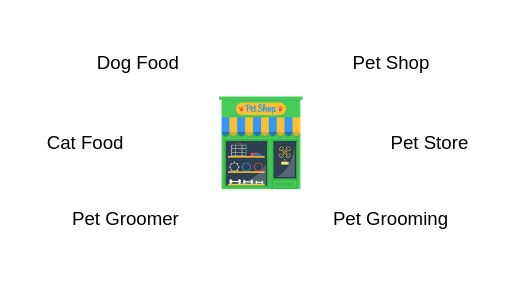
Those main keywords will give you a good reference which you can build out possible long tail keywords that may work for your business.
Let’s see them in action. If your shop is located in New York and operating 24 hours, these are some of the long tail variations:
- Best pet shop at New York
- 24 hours pet shop at New York
- New York Pet Grooming
- Best dog food at New York
- Buy dog food near me
- Buy cat food near me
If you are not sure what keyword to use, you may go to your analytics to see the general keyword phrases that lead visitors to your website. These keywords may be relevant to your whole website but may not be highly targeted by a single page on your site.
To start looking for the keyword phrases, simply go into your analytics and locate your organic keyword referrals: Acquisition > Campaigns > Organic Keywords

Go through all the terms for relevant long tail keywords you can use in your content. If needed, you can also filter the searches with only the keyword that is relevant to you.
2. Use the search engine
If you’ve run out of an idea in your brainstorming session, you can always turn to search engines for help. This is the simplest and most efficient way to generate long tail keywords. No matter what niche you are in, the following handy features from Google allow anyone to easily find long-tail keywords. Plus, it’s free!
All you need is to go to Google and start a search with your main keyword.
Google Autocomplete
Google Autocomplete is one of the awesome sources of high-intent long-tail keyword that you can get.
As what Google mentioned:
“We look at the real searches that happen on Google and show common, trending ones relevant to the characters that are entered and also related to your location and previous searches.”
Just start typing your keyword into the Google search box and see the Google Autocomplete variations:

In the example above, you can see that typing the letters “pet grooming” brings up predictions such as “pet grooming shop” or “pet grooming shop near me”, making it easy for you to find more long tail keyword variations.
People also ask
Next, check the section on “People also ask”. This section contains four questions together with their answers.

If you expand one of the questions, you will see an answer and a lot more questions comes beneath it. To optimize for voice search, these questions are usually a good place for you to start.
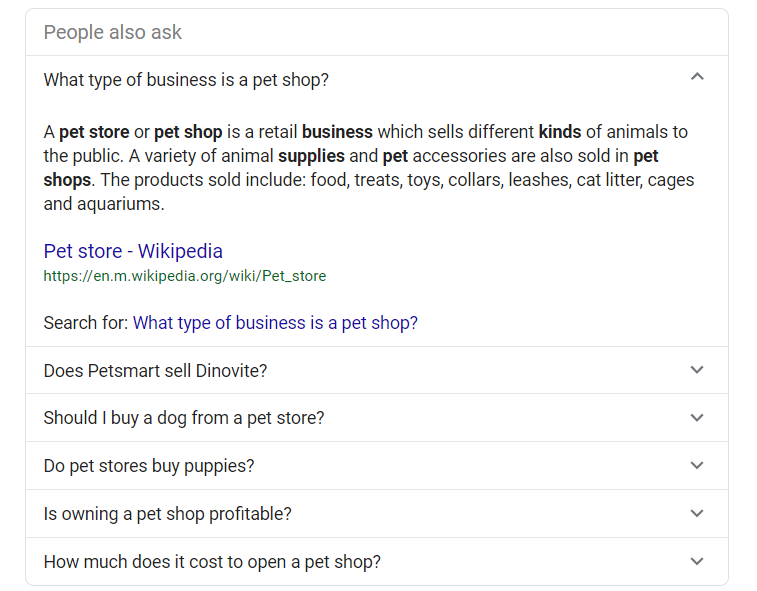
To get a chance to appear in the question box, create quality content clearly answers questions about your topic or service.
Searches related to
Not to forget, the “Searches related to” area that you can find at the bottom of the search results.
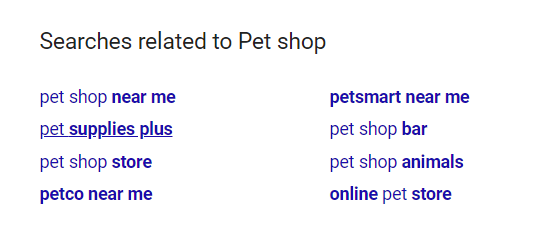
As you can see in those results, Google is suggesting terms based on what people are searching for. These long tail keywords may not necessarily have high search volume, but these are the high intent keywords your potential audience is using in their day to day life.
This is also a great way to find long tail keyword variations that are relevant to short tail keywords. In deciding which long tail to use, I recommend you to pick only the keyword which is relevant to your content.
3. Use BiQ’s Keyword Intelligence
You can easily find long tail keywords opportunities by using the advanced filter in BiQ’s Keyword Intelligence.
Simply enter your target keyword on the search. Then, click the ‘Advanced Filter’ to view only the long tail keyword. Other than that, you can also select the level of relatedness of the related keywords.

Once you are done, click ‘Filter Keywords’ and you will see a list of long tail keywords ready to be used.
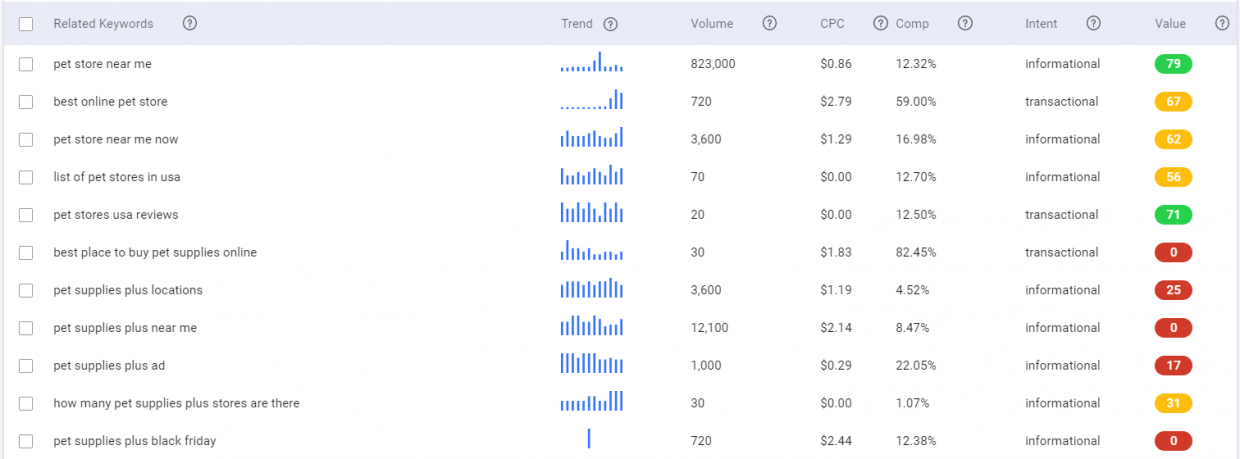
If you are not sure which long tail keyword you should use, you can sort the keywords based on its ‘Value’. It is a measurement of how valuable the keyword is. Higher-Valued keywords will give you more traffic at a lower competition.
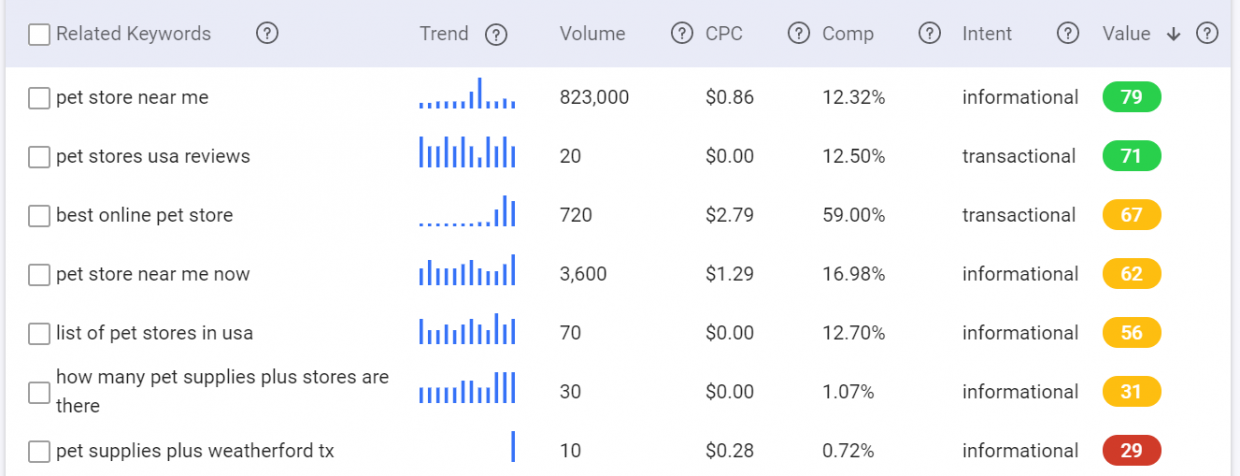
Nevertheless, always consider the relevancy of your topic when choosing which long tail keywords to use. A high valued keyword with a relevant long tail keyword would be the perfect fit for your content.
Click here to get free access to Keyword Intelligence.
4. Use LSIGraph
Just add your keyword in LSIGraph and it will return keywords that are semantically related to your main keyword.
For instance, the term “pet grooming” comes back with a list of LSI keywords:
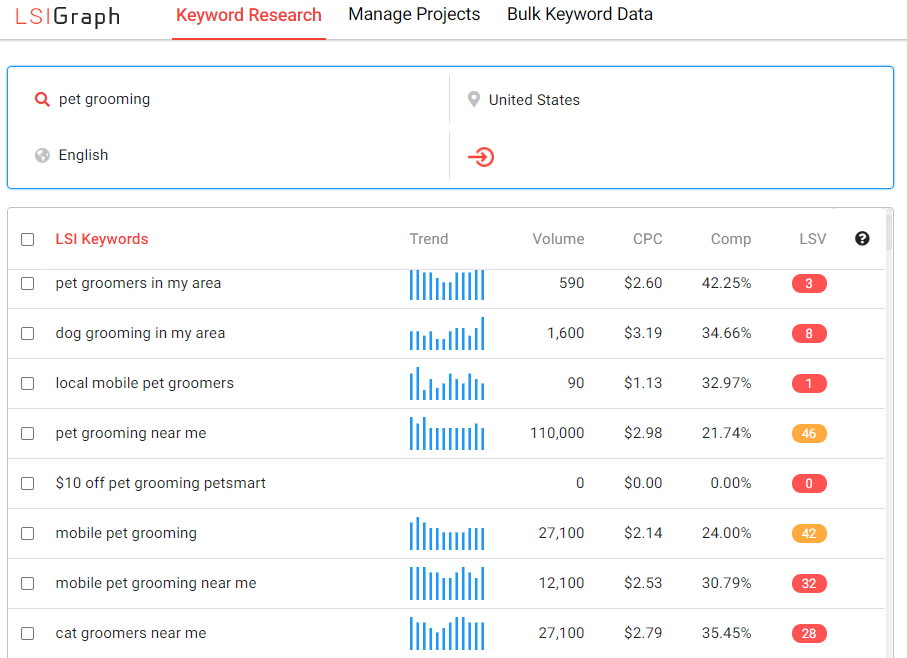
What’s great about LSIGraph is it allows you to select the location and language of your choice. This is especially good when your content is targeting a specific location as you can see a list of keywords that are more related to the local intent.
As mentioned by LSIGraph:
“Latent semantic indexing (LSI) keywords are essentially keywords that are semantically related to your main keyword, used in a search query.”
By making use of LSI keywords, you can easily optimize your content without stuffing the same keywords. They are used to support the main keyword and helps to give context to the content so that search engines and humans can better understand them.
5. Use Quora
Quora is known as the giant database of questions and answers. Other than being a great place to get content ideas, it can also be used to find your long tail keywords.
When you are on Quora, use the search bar to search for a generic topic. Just add in your keyword and you will notice that each question is searchable around that keyword.
Let’s use the same example; pet grooming. You will immediately see a list of questions:

These questions are asked by real humans with real intentions. Therefore, you may want to seize the huge potential by creating new content or update your existing piece using that very keyword to optimize it.
Remember Google’s Related Searches section at the bottom of the search results?
Quora has something similar too!
After clicking on any of the questions on Quora’s result, you can see that there is a list of related questions on the right-hand side of your screen.

Other Question and Answer sites you can explore more are Yahoo Answers, Answers.com, and LinkedIn Answers.
The Next Step: Start Finding the Best Long Tail Keywords
In the end, what really matters is the effort to deliver high-quality content to your readers.
By now, you should have some idea on the benefits of long tail keywords and how to find them, it’s time to start implementing them in your content. Use them to provide real value to your audience that will make them want to stay on your website.
The rule of thumb is to always put your audience first. Take into account how your audience thinks, speak and react about your business, products or services. Knowing the intent will make your long tail keywords strategy more meaningful than ever. Check out this article on why excelling user intent is the new trend in SEO.
So, start using long tail keywords in your content and reap the rewards of all your hard work in the near future. Go forth and conquer!




